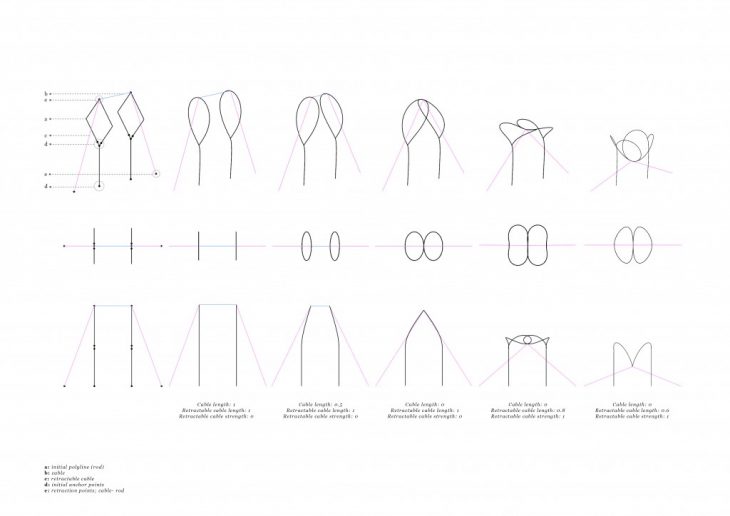
Architecture is in general a static system of spatial configurations which has become vastly rigid and uniform. In the context of newfound capacities in computational design, materiality and construction, the topic of systems that have the ability of dynamic reconfiguration and spatial enclosures with minimal amount of material has been largely introduced. Temporary, lightweight and transformable structures provide an efficient means of spaces that can evolve, change or adapt according to a certain need or environmental stimuli. Integration of structural principles for the design of lightweight structures increases the efficiency of transformable structures
This research aims to develop a novel structural system which generates spaces that evolve from their first state, therefore have multiple integrated performances triggered over time. A system which can respond to a dynamic environment to improve design criteria performances.
Within studios objective to challenge and investigate elimination of gravitational constrains in the production of architectural devices, this research started with non gravitational and formal behavior research. The objective was to extract and analyze morphological features and behaviours from experiments of manipulated fluid matter with the intention of learning from behavioral and formal responses. By using photogrammetry to scan formations, 3d models were generated which allowed better understanding of the repetition, changes, redundancies and growth of these forms.
_formal results from initial experiments


_photogrammetry: 3d scanning _behavior in time { bending + structural hierarchy }
_behavior in time { bending + structural hierarchy }
 The foremost extracted features are three- dimensional curved geometries with high bending elements. Bending-active structures are structural system that employ bending and base their geometry on large elastic deformation from an initially straight or planar configuration to induce form and structural qualities. (Knippers, 2011) On a structural level, they are curved structures influenced by residual stresses in their load bearing behaviour and structural capacities. Although, the mechanical principles are very well understood, formal and structural potential of bending-active structures is still open for exploration and higher implementation. (La Magna, 2016)
The foremost extracted features are three- dimensional curved geometries with high bending elements. Bending-active structures are structural system that employ bending and base their geometry on large elastic deformation from an initially straight or planar configuration to induce form and structural qualities. (Knippers, 2011) On a structural level, they are curved structures influenced by residual stresses in their load bearing behaviour and structural capacities. Although, the mechanical principles are very well understood, formal and structural potential of bending-active structures is still open for exploration and higher implementation. (La Magna, 2016)
The advantages of using bending-active structures are not only in the convinience for transportation and fabrication, possibility to generate complex curved geometries for static structures, but are mechanisms that allow shaping flexible members in different forms and give adaptation possibilities since the capacity to support reverse elastic deformation
QUESTION:
How can we integrate high bending deformations into design principles of transformable structures?
This research explores spring and force based modelling approach considering material behaviour and simulates bending with generative design process. Modelling physical and digital allows compare results and improve structural performance.
_workflow

_elastica
 _prototypes P1.1- P1.5
_prototypes P1.1- P1.5 _prototypes P2.1- P2.1 { multiple equilibrium states }
_prototypes P2.1- P2.1 { multiple equilibrium states }


_bending catalogue




Further steps of the research include implementation of a membrane, designing joinery with degrees of freedom, defining actuators for multiple equilibrium states, structural analysis of solved geometries as well as defining architectural application and scale
MAA02 Climatic Matter Design and Research Studio
2017/ 2018
Student: Zrinka Radic
Thesis advisors: Jordi Pages, Lluís Viu Rebés